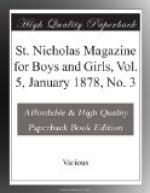“Yes, sir, but that is different.”
“But the principle is the same; can you tell me why?”
Both the boys looked puzzled.
“It is only because the wood does not weigh so much as water; neither are the stones as heavy as mercury, therefore they cannot sink.”
“I wish we could go into the mines. Can’t you take us, sometime, grandpa?” said Harry.
“That is asking rather too much, my child, for quicksilver is not a common metal. There are in the world only four important localities from which it is obtained. These are California, Peru, Austria, and Almaden in Spain. The mines nearest us are in California. I think I shall never go as far as that, but I hope you both may before you reach my age.
“It is a curious story how the mines in Peru were discovered. Cinnabar, when ground very fine, will make a beautiful red paint. The Indians used this to ornament their bodies on grand occasions. This caused the country where they lived to be examined, and the cinnabar was found. The Romans used this paint hundreds of years ago in decorating their images and in painting pictures. It is very highly valued now, and we call it vermilion.”
“Fred,” continued Mr. Lenox, “you spoke of the difficulty of separating gold and silver from the rock in which they are found. Did you know that our wonderful mercury renders valuable aid in this? The rock that contains the precious metal is crushed fine, sifted and washed until as much as possible of the gold or silver is removed; then it is placed in a vessel with the quicksilver, which seems immediately to absorb it, thus separating it entirely from every particle of sand or rock. If the metal to be cleansed is gold, you will see a pasty mass or amalgam, as it is called, of a yellowish tinge. This is heated, and the mercury flies away, leaving behind it the pure gold.”
“How did people learn to do this?” asked Fred.
“They did not learn it all at once. It was only by years of patient effort and frequent failure that they finally succeeded.
“You know there are many gold and silver mines in California,” continued grandpa. “Near some of them large mines of quicksilver have been discovered. You can imagine that this caused great rejoicing, for all the quicksilver previously used was sent in ships to this part of the world, which, of course, made it scarce and very expensive. Now, we can send away quantities to other countries after supplying our own wants.
“Notwithstanding that this strange metal renders such service to mankind—for I could tell you of many other useful things it does—it is a deadly poison. Its vapor is so dangerous that persons searching for it often die from breathing the air where it is found. About seventy years ago, the mines in Austria, took fire, and thirteen hundred workmen were poisoned, and many of them died. The water that was used to quench the fire being pumped into the river Idria, all the fish died excepting the eels. Since that time, spiders and rats have deserted the mines.




